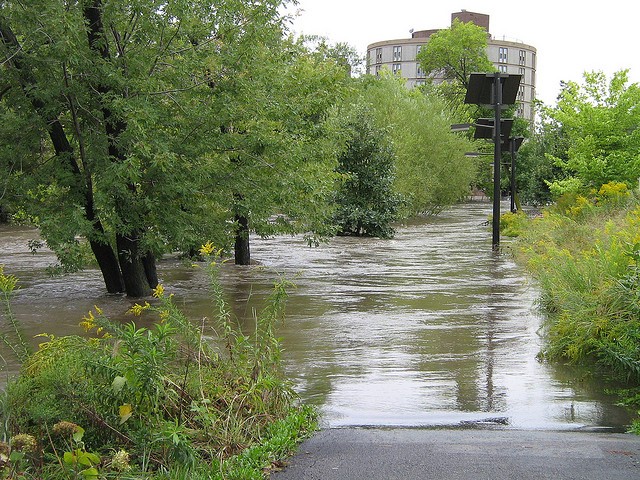Flooding in Chicago Region: “Everything is to blame when ~10% of annual rain falls in 6 hours,” observed Deborah Shore, Commissioner
A Deluge of Water!
“Consider this: More than three inches of rain – 3.09 inches, to be exact – fell in Wilmette, Illinois in the space of six hours (on the night of June 30, 2014). That’s more than nine  percent – 9.26 percent – of the total average annual rainfall in Wilmette in the space of just six hours,” wrote Deborah Shore, Commissioner of the Metropolitan Water Reclamation District of Greater Chicago (MWRD), in an e-newsletter.
percent – 9.26 percent – of the total average annual rainfall in Wilmette in the space of just six hours,” wrote Deborah Shore, Commissioner of the Metropolitan Water Reclamation District of Greater Chicago (MWRD), in an e-newsletter.
“What if nearly 10 percent of all the food you consume in a year was delivered to your table in six hours? What if nearly 10 percent of all the gasoline you pump into your car in a year was pumped in six hours? Food would be spilling off the table and out of the fridge; gas would be pouring out of your tank. It’s inconceivable.”
“Yet that is what happened in the storm that began about 7 p.m. last night and ended at about 1:35 a.m. this morning.”
Magnitude of Overflow to Lake Michigan
“Remember, one inch of rain falling across the expanse of Cook County equals 15 billion gallons of water (and also remember that rain doesn’t fall uniformly across the landscape – it’s usually much heavier in some places than in others). Due to the intensity and volume of this storm, the Metropolitan Water Reclamation District had to open the gates at the Wilmette pumping station and then the Chicago River Controlling Works at the mouth of the Chicago River, ultimately discharging billions of gallons of stormwater overflow to Lake Michigan.”
Landscape Cannot Absorb Rain That Falls On It
“Why did streets fill up and why did water back up into basements? In short, why did such disruption occur? Everything is to blame. No municipal system of sewer pipes can handle that much rain in such a short period of time. These systems are not designed for 10 percent of a year’s rainfall in six hours. Moreover, the Chicago and metropolitan area is flat – and, increasingly, it is also paved or built upon. Not only is there no downhill – nowhere for water to flow to – but with all the building and paving we’ve done at our homes and businesses, we’ve removed the land’s ability to absorb the rain that falls upon it.”
“The Tunnel and Reservoir Plan (TARP) system is operational, and it worked as designed. TARP is comprised of 109 miles of tunnel and two reservoirs. The entire tunnel system holds 2.3 billion gallons of stormwater overflow. But even the TARP’s impressive capacity was pushed to the limit by last night’s storm,” concluded Deborah Shore.
About the Metropolitan Water Reclamation District
The Metropolitan Water Reclamation District of Greater Chicago is a little-known agency with a vital mission. Established by the Illinois State Legislature in 1889 as the Chicago Sanitary District, this new agency was charged with protecting the drinking water supply for the burgeoning metropolis of Chicago.
A major turning point in the District’s history — and a signal achievement — was the development of a plan to capture billions of gallons of stormwater overflow in a huge underground tunnel to reduce pollution in the Chicago waterways. Called the Tunnel and Reservoir Plan (TARP), but popularly known as Deep Tunnel, this multibillion-dollar project was begun in the late 1960s.
“Now, I believe the MWRD is poised on the cusp of a fourth great moment in its history that can define the agency for the rest of the 21st century,” stated Deborah Shore. “This era involves stormwater management. In 2004, the Illinois General Assembly granted authority to the MWRD to manage stormwater for Cook County. This takes the District aboveground, where it must now deal with the rain falling on our landscape.”


